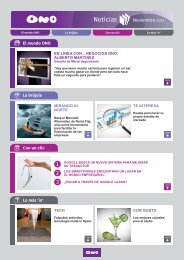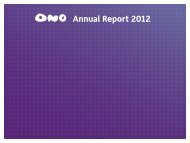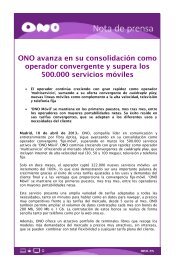Annual report (20-F) - Ono
Annual report (20-F) - Ono
Annual report (20-F) - Ono
You also want an ePaper? Increase the reach of your titles
YUMPU automatically turns print PDFs into web optimized ePapers that Google loves.
second telephony lines. The networks are constructed with excess fiber and duct capacity in order to<br />
allow future upgrades.<br />
The broadband Internet and cable television networks use a hybrid fiber-coaxial transmission<br />
system. The system is broadband and operates over a wide frequency. The forward path uses the range<br />
from 86 megahertz to 862 megahertz, and is capable of carrying voice, data, video and television<br />
channels. The segment up to 630 megahertz is currently used for broadband internet and analog cable<br />
television services and a further 232 megahertz of capacity is used or reserved for digital television,<br />
video-on-demand (“VOD”) and future digital services. Once we have migrated all of our television<br />
customers to our digital television services, we will reuse the analog segment for other services. This<br />
network is also designed to support reverse path operations on bandwidths up to 65 megahertz allowing<br />
interactivity between individual homes and the head-ends.<br />
The digital television system collects all contributions centrally in Spain (except for local<br />
channels which are inserted locally), digitizes the content and distributes it (via our national backbone<br />
network) to the regional head-ends, which act as the insertion points of the digital contents into the<br />
metropolitan network. The analog cable television service is distributed through an analog platform with<br />
head-ends located in each of the Spanish franchises. Unlike with the digital service, the programming<br />
material is collected at each head-end (not centrally), reconfigured to meet our specifications, and<br />
transmitted through optical fibers.<br />
Backbone Network<br />
Iberdrola, a large Spanish electrical utility provider, leases us high capacity fiber-optic cable<br />
linking our Spanish franchises in eastern and northern Spain with each other and with the city of Madrid.<br />
ADIF (formerly RENFE, the Spanish national railway company) provides us with similar fiber linking<br />
Andalucía with Madrid. We completed the lighting of our national backbone network in <strong>20</strong>01 and we<br />
have since then added almost full redundancy to ensure that we can maintain a high quality of service and<br />
network availability for our customers. By the end of <strong>20</strong>04, we were operating 7,575 route kilometers of<br />
high capacity, fiber-optic cable national network.<br />
Our national backbone network has been augmented with a national IP network, which serves as<br />
the basis for our interactive digital television and high-speed Internet services. Our network consists of<br />
twelve nodes connected through high capacity circuits based on our DWDM national network. The IP<br />
network also has multi-protocol label switching (“MPLS”) capability, which allows for the provision of a<br />
wide range of services and in particular better support for business services. It also makes the network<br />
more secure, easier to expand and less costly to operate, in addition to making it simpler to offer value<br />
added business services such as virtual private networks.<br />
The diagram set forth below provides a high level, graphical depiction of our network topology:<br />
General Network Topology<br />
To Interconnection<br />
and<br />
National Network<br />
Primary<br />
Node<br />
Fibre ring<br />
(2 x 128 fibres)<br />
or (1 x 128) + (1 x 96)<br />
Fibre ring<br />
(1 x 80 fibres<br />
and 1 x 48 or 64)<br />
Large &<br />
Medium<br />
Businesses<br />
Access<br />
Network<br />
(Star)<br />
8 Fibres<br />
Terminal<br />
Node<br />
Coaxial &<br />
Pair cables<br />
Amplifiers<br />
125 hp<br />
Taps<br />
Headend<br />
Primary<br />
Trunk Network<br />
Primary<br />
Node<br />
Large: > 50,000 hp<br />
Medium:<br />
30,000 hp<br />
Small:<br />
< 16,000 hp<br />
Primary<br />
Node<br />
Secondary<br />
Node<br />
Secondary<br />
Node<br />
Secondary<br />
Trunk<br />
Network<br />
Secondary<br />
Node<br />
Terminal<br />
Node<br />
Secondary<br />
Node<br />
Secondary<br />
Node<br />
Access Network<br />
(Ring)<br />
Terminal<br />
Node<br />
125 hp<br />
Terminal<br />
Node<br />
125 hp<br />
125 hp<br />
Terminal<br />
Node<br />
Terminal<br />
Node<br />
Terminal<br />
Node<br />
Apartments,<br />
SOHO´s,<br />
Single<br />
dwellings<br />
STM- 4 at 622 MB/sec<br />
STM-16 at 2.48 GB/sec<br />
2,000 hp/node<br />
STM-1 at 155 MB/sec<br />
Terminal<br />
Node<br />
500 hp/node<br />
STM-0 at 52 MB/sec<br />
45
















